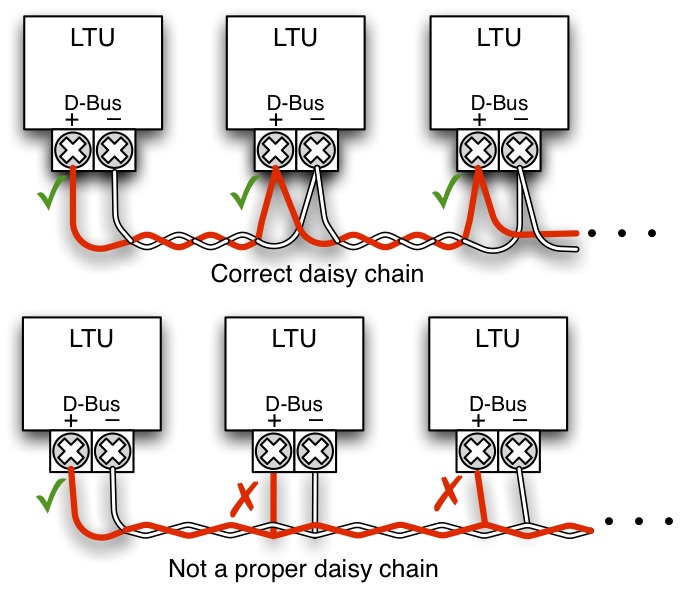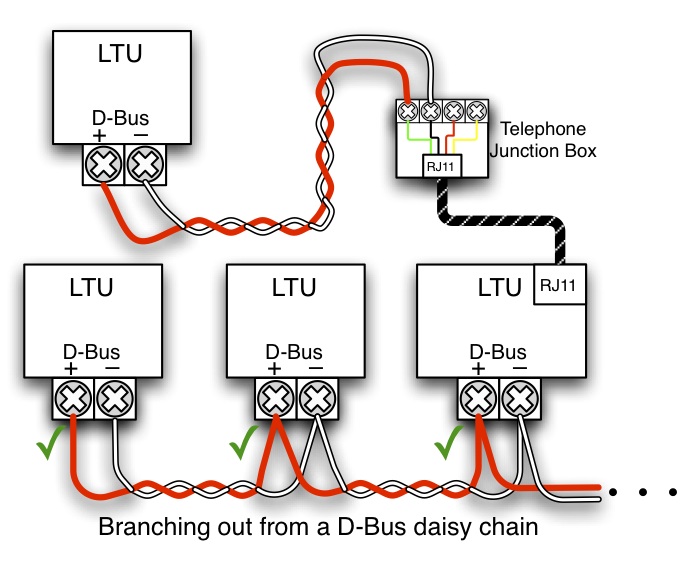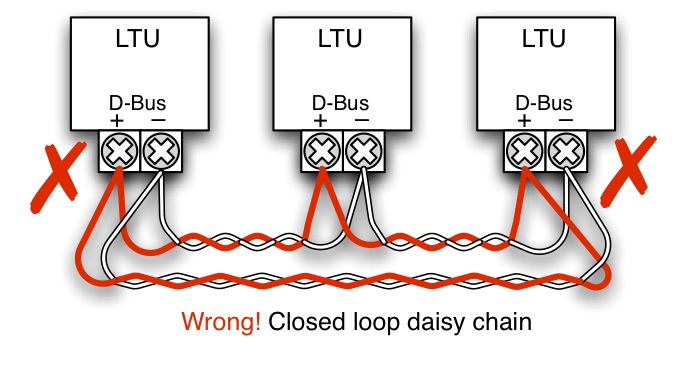- SLCS stands for Smart Lighting Control System. The SLCS is DAE's implementation of a digital lighting control system.
- A BAS lighting control system is dependent upon a centralized computer for its operation, whereas the various components of the SLCS can interconnect autonomously without the need for such a central computer.
- The lighting control of a BAS is not on site, unlike the SLCS which can have on site wall switches for local operation.
- A BAS lighting control system requires the use of an expensive DDC coupled with a costly magnetic contactor, both of which are not needed with the SLCS as the load terminal units already include the relays necessary to directly drive the load.
- The lighting control capability is only an ancillary and incidental part of a BAS, whereas the SLCS is designed for and dedicated specifically for lighting. Thus there are many features of the SLCS that directly benefit lighting control applications that cannot be found in a BAS based lighting control system.
- Given any installation, a digital lighting control system based on a BAS is quite expensive compared to a SLCS which would be quite economical and practical.
- The D-Bus is a proprietary network protocol specifically designed for the SLCS, it is peer-to-peer and not a master-slave network.
- Every device on the network can initiate communication.
- It has low latency and quick response time.
- Commands have no order of priority, but rather the latest command will always override prior commands, all commands will elicit a response unlike in central/manual hybrid systems where there is a distinction between local and remote control.
- An optional common access point is a device that can access all the LTUs on a given D-Bus network. The CAP can be touch panel, a computer or even an intercom. The CAP interfaces with the D-Bus network through a CC500 or CC1000 D-Bus gateway.
- It is possible to attach multiple central control system to a single SLCS network for multiple points of access, not just for the purpose of convenience, but also for redundancy. For example, one can have a central control system at the security office, while another is located at the reception, with both existing simultaneously with the local digital switches.
- The CMS does not need to continuously poll the status of the SLCS devices as the CC500 or CC1000 will automatically take care of monitoring the SLCS network so that the CMS can immediately obtain the real time data of the SLCS network at any time directly from the CC500 or CC1000.
- The CAP performs a group on/off control by issuing a group command. The group is formed by the various devices which constitute the group itself on the same SLCS network. It is not necessary to issue separate commands to each member of the group. The advantage to this method is that it is highly portable, as multiple CAPs do not each need to learn which members are part of the group, all it needs to know is the group number in order to issue the on/off command to any group. This approach is also highly concurrent, as all the devices receiving the group command can activate simultaneously.
- Implementing the group capability as a single group command is in contrast to the more conventional approach of implementing it through software. Wherein the software itself takes care of knowing which devices belong to any given group. The software method has the advantage of flexibility, but the disadvantages of needing to change the program every time a group member is changed and is not easily portable to another CMS, the tendency for the various CMS become out of sync in time is great. Also, its simultaneity is very poor, as each device will need to be activated individually one by one.
- A digital lighting control system is an innovation over and a replacement for traditional lighting controls, and does not necessarily require a central control system. A central control system belongs to a higher tier of functionality.
- Although an activation schedule can be implemented by the central control system, but it cannot do so in synchronization with the local digital switches, touch panels or other points of access. A central control becomes a nonviable alternative for those installations in which it is necessary to have local controls at the same time.
- Even if an installation requires only central control without the need for local controls. The cost of such a system is very high due to the extensive wiring and labor cost involved to wire the central system with the terminal units.
- The smart lighting control system provides capabilities that are not possible with a conventional lighting system. Such as multiple points of access, remote access, reconfiguring the load grouping at any time, using a touch panel interface, scheduled activation and so on.
- Maintaining or changing existing load terminals is easy, while adding new loads can just as easily be done anywhere where the D-Bus already passes through.
- In a conventional lighting system, the load and control need to be located in close proximity, whereas with the SLCS, the load and control are decoupled, and each can be located where it is convenient for the user instead of being limited by the constraints of the physical wiring.
- With an SLCS, control does not need to one-to-one, but rather it is possible to have multiple switches controlling the same load. Conversely, multiple loads can be controlled by the same switch as a group or as a pattern. Or even a combination of both.
- For a public facility, the most attractive feature is the ability to have both centralized and localized controls installed and in use at the same time.
- There is no central processor, it is very similar to the C-Bus, but unlike that of Toshiba's or Panasonic's which require a central processor. The central processor is a device that arbitrates communication between all devices, without the central processor, the entire network collapses and cannot function, it cannot even perform setup or configuration.
- Specialized models for assimilating conventional mechanical switches as if it were a digital switch, a model specifically designed for interfacing with magnetic contactors, and a model for connecting with IR sensors.
- The SLCS can be integrated with a BAS using a Modbus/D-Bus gateway.
- Attractive color touch panel at a reasonable price.
- The integration of the load terminal and up to 4 relays all into one compact enclosure, simplifying both the installation process and reducing labor costs.
- Integration with infrared programmable remote controls. Auto learning capability for easy configuration (similar to the C-Bus).
- Web based automatic activation schedule controller.
- Suitable for small to large scale applications.
- A maximum of 64 LT units can be connected to one D-Bus network. Each LT unit must have its own unique address and may not overlap. The address of each LT unit is set using the DIP switches on its front.
- LT stands for load terminal. Each LT can have from one to eight channels; each channel can control one lighting circuit; each circuit can consist of one or more luminaires; the number of luminaires being limited by the relay or dimmer driver.
-
Two wires carry the D-Bus signal wire, while the other two carry power.
- The red wire should be designated as positive (+), while the white wire should be regarded as negative (-), positive connects to positive, while negative connects to negative.
- The devices to be connected in the network should form a daisy chain and not a branching network, see diagram for a correct and incorrect daisy chain.

- If a branch is necessary, one should use the RJ11 connector on the LTU when it is necessary to extend an existing branch as the LTU contains a built-in repeater.

- It should not form a closed loop.

- Yes the LT unit requires a separate power supply, but it does not have to be a system power supply. The power supply can be a generic third party supplied power supply, it does not have to be a vendor proprietary power supply. The power supply can either be a 24 Volt DC or AC. A single 15 watt DC power supply can typically supply from 3 to 4 LT units, depending on the model.
- Auto learning means that groups and patterns can be learned by the LT units without complicated programming. Simply tell the LT units what channels are part of the group or pattern, then issue the same group or pattern command, and the LT unit will now learn the new group or pattern. The process does not require any special programming tool or software running on a PC.
- Configuration through auto-learning can be performed on an individual LT even if the other parts of the system have already been configured, as is the case when one is performing a replacement.
- Manual configuration is associated with the auto-learning capability. It means that the operator can configure the desired group or pattern using only the LT unit itself, an IS digital switch and a screwdriver; there is no special device or software involved.
- Manual configuration can configure only up to the first 9 groups and the first 6 patterns.
- No, LT addresses may not be duplicated, each one must be unique within a single D-Bus network.
- A group is a collection of lighting circuits that behave as one for the purposes of on/off control. A group can be considered as a virtual circuit, it is a way of reconfiguring the lighting circuit layout without having to physically rewire the entire system.
- A pattern is also a collection of lighting circuits, but instead of being turned on/off together, it forms a pattern that is a combination of both on and off at the same time. Thus a pattern can only be activated; there is no "off" to a pattern.
-
A D-Bus system can have up to 63 groups and 64 patterns.
- The CC500 and CC1000 are gateways that allows a third party system with Modbus communication to connect with the SLCS D-Bus network. It converts the Modbus protocol to D-Bus protocol and vice versa. It also acts a data collector by buffering the activities within the D-Bus network, and can provide the status information to the third party system on demand instead of having to poll the data from the units one by one.
- No, a central control system is not necessary. The various components of the SLCS all have their own intelligence built in with all the necessary logic and programming necessary to function with having the need for a central control system or central processor to act as a mediator.
- The D-Bus system is built from the ground up as a digital lighting control system and all the specific and necessary protocols and logic are designed into the system, which is why no central control system or processor is necessary.
- Although a central control system is not necessary, a third party central control software can be used for the purposes of monitoring and controlling the system from a single location. However, this is entirely optional on the part of the proprietor.
- Conceptually, a pattern can be used to replace a group and a group can also be used to replace a pattern. For a pattern to replace a group, two patterns must be used; a pattern for "on" group and another pattern for "off" group. Conversely for a group to replace pattern, two groups must be used; a group for all the "on" lights and another group for all "off" lights.
- This is why both are provided, as they are similar but conceptually different in their purpose and usage.




